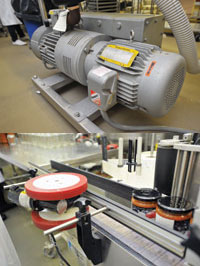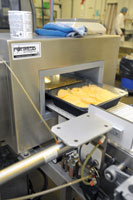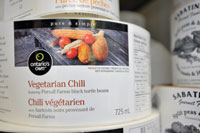
Local loyalties
By Andrew Joseph, Features Editor
Automation Carole-Ann Hayes chilis Dan Donovan Jamie Kennedy Ontario’s Own purées Royal Ontario Museum Sabatini’s Gourmet Foods soup mixes stocks Umberto SabatiniOntario co-packer keeps things pure and simple for a fast-growing brand of locally-sourced soups and sauces
Keeping things pure and simple seems to come naturally for Carole-Ann Hayes, president of a fast-growing Ontario producer of high-quality soups, sauces and preserves made exclusively from locally-grown fruits and vegetables under the expert guidance from one of the country‘s best-known celebrity chefs.
Since starting up in 2009 under The Great Ontario Food Company banner—better known as Ontario’s Own after the filing of a formal ‘doing business as’ request—the Toronto-headquartered company has quickly acquired a knack and growing industry reputation for its ability to source locally-produced food ingredients captured at the peak of their freshness to develop a mouthwatering array of soup mixes, stocks, purées, chilis and other wholesome creations with an unmistakable ‘home-made’ taste and texture profile.
Home Base
“We did not want to call them ‘home-made,’ because we think this is now a much-abused term,” says Hayes. “We prefer to call them ‘lovingly prepared’ instead.
“That’s why we decided to use one of Canada’s top chefs, if not the top chef, to work with us on our plan to support Ontario’s family farms and local economies by offering foods that are grown close to home.”
Along with marketing specialist Hillary Graham, Hayes recruited Dan Donovan—a renowned chef who had recently worked as the executive sous chef at the Royal Ontario Museum in Toronto—as the company’s product developer.
According to Hayes, the fact that Donovan had learned the art of cooking as an apprentice to the world-famous celebrity chef and restaurateur Jamie Kennedy, who also happens to be a vocal supporter of using locally-grown and produced food products, made him a natural fit for the company’s ambitious plans and vision.
“The first thing we did was contact Jaime Kennedy to help us create the recipes,” recalls Hayes. “We were excited to work with Jamie since he was championing a cause we could really sink our teeth into, and he knows how to create authentic but simple dishes, which in some cases would be considered comfort food.”
Adds Hayes: “Jamie has an iconic status with local farmers because while he always creates great meals and it is always done with an eye towards supporting the local farmers, which is something that we strive to do with Ontario’s Own to make it unique in the marketplace.”
At the moment, Ontario’s Own is using Jamie Kennedy recipes for marketing three of its popular product lines: Chicken Noodle Soup, using Rowe Farms-supplied chicken; and Sauce Bolognese and Chili con Carne, with both products using tomatoes supplied by the Thomas Utopia farms.

Motors designed and manufactured by Baldor Electric Company (top) power an ILPRA tray-sealer and a Pack Leader Packaging Systems PL-501 labeler at the Sabatini’s Toronto facility.
Other products currently marketed under the Ontario’s Own brand label include:
- Tomato Soup, using tomatoes grown in the province’s southwestern-based Essex County;
- Roast Carrot Soup, using carrots grown at Carron Farms;
- Butternut Squash Soup, using southwestern Ontario butternut squash;
- Vegetarian Chili, using Persal Farms black turtle beans;
- Chicken Stock, using Rowe Farms chickens;
- Vegetable Stock, using Soiled Reputation Farm vegetables;
- Tomato Sauce, featuring tomatoes from Kerr Farms;
- Peach Puree, using Cherry Lane venture peaches;
- Pear Puree, using Andrewes Farm bartlett pears;
- Organic Pear Puree, using Filsinger’s Organic Foods & Orchards’ organic orchard pears.
While Hayes says the company’s ultimate goal is to have all of its raw produce grown in Ontario one day, she points out that all Ontario’s Own brand products already contain at least 98 per cent Ontario-sourced ingredients by weight.
To actually manufacture its products on a commercial scale, the company recruited the services of well-established nearby contract food manufacturer and co-packer Sabatini’s Gourmet Foods—a family-owned, 40-employee operation in northern Toronto that co-packs about 300 SKUs (stock-keeping units) of many popular private-label and brand-name food products, including soups, pasta dishes, dips, sauces, and various ethnic-cuisine offerings.
Hayes says Sabatini’s was highly recommended to her by several referrals as reliable, quality-driven third-party manufacturer and co-packer, with a wealth of experience in helping new food products find a place on store-shelves of major supermarkets and independent retailers.
Happy Thoughts
“I am happy to tell everyone that Sabatini’s is my co-packer, although in truth I really like to think of them as my partner in this venture,” Hayes remarks, adding she is also appreciative of Sabatini’s increasingly helpful role in the actual sourcing and purchasing process.

A Fortress Technology metal detection system ensures complete product integrity on every product manufactured at Sabatini’s.
“Ontario’s Own came to us in the summer of 2009,” recalls company president Umberto Sabatini. “And while they provided us with the recipes and the shopping list of which farmers to buy the ingredients from, it wasn’t long after that I took over dealing with the farmers directly.”
Founded by his father Giorgio back in 1975, the company has always managed to maintain unwavering commitment to high-quality production methods and keen focus on combining prepared convenience foods with fresh ingredients and authentic taste by utilizing advanced packaging techniques and technologies, according to Sabatini.
“When we first opened our doors in 1975 we were operating out of a 3,500-square-foot room, but despite the small size of the operation we were completely dedicated to bringing forth a high-quality product with a taste that would bring the customer back for more,” Sabatini told Canadian Packaging on a recent visit to the company’s Safe Quality Food (SQF)-certified facility, recently expanded to 16,000 square feet to accommodate the growing business, which also includes production of Sabatini’s own branded products.
Sabatini credits the company’s relatively early embrace of MAP (modified atmosphere packaging) methods and technologies to extend product shelf-life for giving it a strong competitive edge in the co-packing business, and Hayes wholeheartedly agrees.

Utilizing labels manufactured by Techmark Labels, a Pack Leader PL-501 labeler quickly applies adhesive-backed labels to the Ontario’s Own glass jars.
“Although our products contain no preservatives, the way that they use our recipes to make the food and package it provides an unopened jar with—depending on the product—a shelf-life anywhere from three months for the soups and up to two years for the purée products,” says Hayes.
While most of the products made and co-packed at the plant are packaged in plastic trays, Sabatini’s also utilizes various types of pouches, aluminum trays and glass jars, with the latter being the packaging of choice for Ontario’s Own products.
“We like the glass jar look,” Haye states, complimenting the high quality-finish of 725-gram glass jars made by leading packaging glassmaker Owens-Illinois, Inc. (O-I) and supplied to the Sabatini’s plant by Richards Packaging Inc. along with the lidding.
“It presents a more traditional look to our products, one that actually looks like it comes from a farmer rather than a big conglomerate,” says Hayes, while lauding the inherent recyclability and other sustainability virtues of glass packaging in general.
To give the jars a matching complimentary look, Hayes turned to the services of Toronto-based branding services specialists Watt International Inc. to create an attractive label that would help capture consumer attention at the shelf level, while conveying the branding theme of food being carefully grown, picked, preserved and delivered in traditional ways—from farmers right to the consumer.
Farm to Fork
“When Ontario’s Own first approached us, I knew this was a project we wanted to be involved with,” recalls Watt’s executive vice-president of creative and client services Randy Redford.
“And after our initial meeting, I decided to take on the project myself,” says Redford, who played a key role in developing the brand name, logo and packaging concepts in time for the products’ May 2009 launch.
According to Redford, the package labeling created by Watt aims to relate the brand’s position as a product that would support local Ontario farmers; provide Ontario families with better choices; leave the smallest environmental footprint possible; and contribute to the financial fortunes of local farmers, processors, distributors, retailers and restaurants.
“I really like how our labels feature the name of the farm that produced the main product ingredient,” says Hayes.
Adds Sabatini: “All of us at Sabatini’s really love the labeling.
“It really does make you think of a fresh farmer’s product,” he says.

Workers at the Sabatini’s plant carefully fill jars of Ontario’s Own Sauce Bolognese created from a Chef Jamie Kennedy recipe.
“The white label has simple black lettering combined with bold color photography of the main ingredients, while still presenting the consumer with a large amount of viewing space to see the product inside the glass jar.
“It is very sharp-looking; it really stand out on the shelf to grab the consumer’s eye,” Sabatini states.
He’s not the only one to think so.
At the recent national PAC Leadership Awards competition of PAC-The Packaging Association earlier this year, the Ontario’s Own brand pulled off a remarkable double feat—being selected as a Gold Winner in the New Product Launch segment of the Brand Marketing Category and as winner of the prestigious Best-of-Show PAC Packaging Award, earning special praise for the product’s positioning as a socially- and environmentally-conscious quality brand.
The Sabatini’s plant employs a PL-521 horizontal wraparound automatic labeling machine—manufactured by the Taiwan-based Pack Leader Machinery Inc.—to dress up clear glass jars after filling with the award-winning labels, which are flexographically printed by Burlington, Ont.-based Techmark Labels on a Scout model narrow-web press manufactured by Mark Andy, Inc.
While Ontario’s Own is still a very young brand, Hayes says she’s pleased with the fact that it now retails in the province of Ontario from as far west as London to Whitelake in the east through select Loblaw and Metro supermarket locations, while becoming a much sought-after product at many smaller specialty grocers such as Pusateri’s Fine Foods, Pusateri Fruit Market, Longo’s, Remark Fresh Markets, Nature’s Emporium, Garden Basket, Michael-Angelo’s Gourmet Foods, McEwan Foods, Organic Garage, Multiple Organics, The Sweet Potato, Green Earth Organics, Harvest Wagon, The Big Carrot, Summerhill Market, The Health Shoppe, The Village Grocer, Vincenzo’s and Castlegarth.
“Despite having two renowned chefs creating recipes, the Ontario’s Own brand really isn’t just about the recipe for us,” states Hayes.
“The product source, and how you make the product and package it are equally important to us,” she concludes. “And Since Sabatini’s helps us do all that—dealing with the farmers, sourcing our jars, manufacturing the product and applying the labels—we could not be happier about having them as our co-packer of choice.”
Photos by Cole Garside
Advertisement


